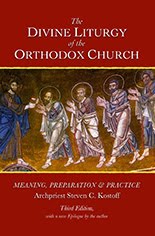Dear Parish Faithful & Friends in Christ,
| St John beholding the vision of the Son of God in glory, holding the Seven Stars, with the Seven Lampstands, surrounded by Seven Angels holding small churches. (REV Chapter 1) |
I am not quite sure what anyone - Christian or not - may expect if making a decision to pick up and read The Book of Revelation. Even considering my uncertainties, though, I feel somewhat certain that for many readers what they may be expecting is a book filled with images of "end of the world" disasters of unprecedented magnitude and inescapable finality since they are the punishing actions of an all-powerful God.
Apocalyptic would here mean the final act in a divine-human drama in which the sovereignty of God is finally revealed to an unrepentant and sinful humanity. Many will be "saved," but many will be "lost." These revelatory events are presented within the context of coded and cryptic symbols that are supposedly typical of the Bible. Perhaps the most prominent of those symbols just may be the highly-symbolic number 666, itself conjuring up further frightful images of the "Antichrist" or slavery to some malignant power that will control those deemed sinners once that number is indelibly stamped across their forehead. If you are unfortunate enough to be so-stamped and therefore aligned with the Beast of the Apocalypse, it means one thing for certain: your fate is sealed and you are doomed. The recent popularity of the Left Behind series would only affirm such an assessment of the last book of the Bible.
It is undeniably true that The Book of Revelation is clearly filled with an endless display of images and symbols that have baffled commentators over the centuries and which have led to an endless string of misplaced predictions of the end of the world. To put that more bluntly: every prediction of the "end of the world" based on The Book of Revelation up to this point in history, has proven to be wrong. That much is clear. But that is certainly not the whole story of this challenging book.
All of the images that haunt the popular imagination - as do the four horsemen of the Apocalypse - with the prospect of doomsday destruction are presented within a work that is profoundly and powerfully pastoral. St. John, the recipient of these visions - both visionary and auditory - writes as a prophet and pastor who is more concerned with the growing, but beleaguered and besieged, Christian Church of the late first century, than in telling the world of its own inevitable demise at the hands of a wrathful God. St. John's intention is to encourage, strengthen, and console the Church amidst and through any adverse conditions in which she may find herself. And that is what it means to be pastoral.
In fact, after the initial description of a magnificent vision of the Son of Man (REV. 1:12-16), St. John is commanded to write letters to the angels of the seven churches of Asia Minor. These seven letters that fill up chs. 2 & 3 are profoundly pastoral. That means, first of all, that these letters are honest; thoroughly realistic in their assessment of human strengths and weaknesses; filled with encouragement and admonition; and able to penetrate below the surface to the underlying reality of the Christian community being addressed.
And these seven churches - symbolic of the entire Church because the number seven means fullness - have things to be praised and things to be admonished for within their respective lives as Christian communities. These seven churches, by way of reminder, belong to the western coast of ancient Asia Minor (present day Turkey) and are named after the respective cities in which they reside: Ephesus, Smyrna, Pergamum, Thyatira, Sardis, Philadelphia and Laodicea. If any of these names sound unfamiliar to you, then you have some reading and studying to do. Each of these early churches are addressed by the Risen Christ, through his servant John who is in exile on the island of Patmos (Rev. 1:9).
All seven letters have an identical structure: 1) The title or description of the speaker (the Risen Christ); 2) The present diagnosis of the church, with both the strengths and weaknesses of the given church honestly assessed; 3) encouragements or admonitions; 4) a promise of blessedness to those who persevere in their fidelity to Christ and the Gospel. Three of the churches - Ephesus, Pergamum and Thyatira have both good and bad traits; two of the churches have no bad traits mentioned - Smyrna and Philadelphia; and two churches hear nothing good from the Lord - Sardis and Laodicea. So much for idealizing the early Christian centuries as a "golden age" of fidelity and firmness of spirit!
From this we learn immediately that local churches are not all alike. Each has a unique life with a specific set of circumstances that sets it apart from its neighboring churches. The three main themes that dominate these letters are: 1) the problem of assimilation to the surrounding culture; 2) the problem of persecution (at the hands of the Roman Empire; 3) spiritual complacency.
Thus, the Lord challenges these churches - and us today, even more importantly - to consider just how far we can assimilate ourselves to the surrounding non-Christian culture and still maintain our identity as Christians.
This assimilation can come in the form of a temptation to listen to false teachers and their false teachings. Or, it could include a more general uncritical acceptance of the given cultural norms of a particular society/culture that allows us to be so like our non-believing neighbor, that we are hardly like Christ at all.
The issue in the first century was that of eating meat sacrificed to idols. The question for us is: just what current idols occupy our minds and hearts? In North America we are not being openly persecuted by being thrown into prison or having our very life threatened. Though other Christians in the world are suffering persecution today. They are encouraged by Christ to persevere even unto death and thus earn a crown in the never-ending Kingdom to come. A hard message indeed.
Perhaps the temptation of complacency is our greatest threat to be dealt with. Losing our "first love" (REV. 2:4); being preoccupied with wealth and status to the point that we are then spiritually poor (REV. 3:17); unconcerned about doing the works of the Lord (REV. 3:2), etc. Perhaps the most frightening admonition - basically a warning and a threat - is that if we are "lukewarm" than Christ will "spew" us out of his mouth (REV. 3:16). Such a fallen church can still repent, for the Lord spoke these words to the Laodiceans: "Those whom I love, I reprove and chasten; so be zealous and repent" (REV. 3:19).
We are taught to fear the Lord, for such fear is the beginning of wisdom. Yet, we need not "fear" reading The Book of Revelation if done so with care and vigilance -and perhaps with some sober guidance..
We do need to fear would-be prophets and self-proclaimed spiritual leaders who manipulate naïve and innocent souls by pouring fear into their minds and hearts with a one-sided and self-serving reading of Revelation which offers a caricature of God as a harsh and implacable divine Judge. (And North America has produced a gallery of such characters through the years).
This book is filled with passages of unparalleled beauty about the grandeur and glory of the Kingdom of God. The stunning beauty of chs. 4 & 5 alone make that point. The whole purpose of the book is to reveal to us that God will prevail "in the end" against all forms of evil and other distortions of his creation and purpose for us and the world. If the Bible begins with Genesis, then it ends with Revelation. At the center of this all-embracing "story" is Christ and the Cross and Resurrection. The "story" is directed by the One who says: "I am the Alpha and the Omega... who is and who was and who is to come, the Almighty" (REV. 1:8).







